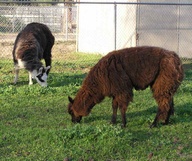 This llama eats grass.
This llama eats grass.  His friend wants to try it too.
His friend wants to try it too.
Lama (with one L) is the name of the genus including both species Lama glama (llama) and Lama paco (alpaca). Both can be found at the UC Davis Vet Med Teaching Hospital. Both species, said to have been some of the first animals domesticated by humans, are of particular interest to equine surgeons who say there are many similarities between horses and the ruminant pack animals from South America, which are more closely related to camels. Because llama and alpaca have become popular pets in California, veterinary medicine students have created their own llama club. Visit llamapack.com or Wikipedia to learn more.
Oh, and llama poop makes excellent fertilizer and is easy to gather, because they poop in little piles that look like a pyramid of rabbit pellets! Llama manure is considered by many to be the best by-product of this remarkable animal. One major benefit is the lack of any significant odor which makes this product ideal for indoor plants. The dung is high in nitrogen in comparison with other natural manures and can be used on plants without the danger of burning them - this makes composting unnecessary. Llama dung is also being used as a filtration system in Bolivia to neutralize acidic, metal-laden water supplies; this low-tech "bioreactor" system harnesses microbes living in the manure to neutralize the acidic water and remove most of the dissolved metals.
Llamas and alpacas are also treasured for their wool. They're closely related to the vicuña, whose wool is widely considered to be the most luxurious wool in the world. Your local yarn geeks can probably say more about this. You can see some crafts made from alpaca wool at Redwood Barn Nursery. Yolo Wool Mill sells alpaca and llama yarn, as well as some finished objects.
Llamas are the perfect high-altitude, low-impact pack animal - these gentle spitting creatures can carry one-third of their body weight. But wait! Don't just let those valuable llama turds fall by the wayside as you trek up the mountain... save it for your campfire at night. On those cold, tree-barren high-mountain ascents, you'll be grateful to start your fire with some dry llama dung in the absence of any firewood. Though the dried pellets burn much like charcoal briquettes, the smoke has a pungent aroma.
See also: Spiritual Organizations
 |
| Caution: Drama Llama Crossing. Avoid getting near one or it will drag you into its undergroundnest and get you involved in its "OMG SO SRS" issues. |



